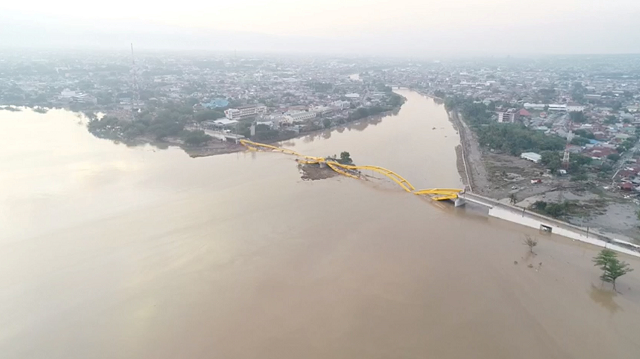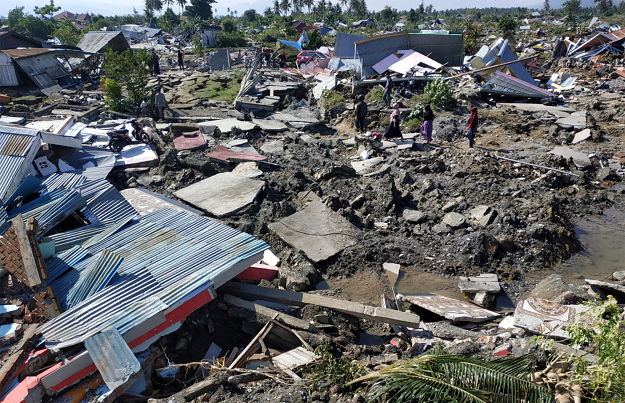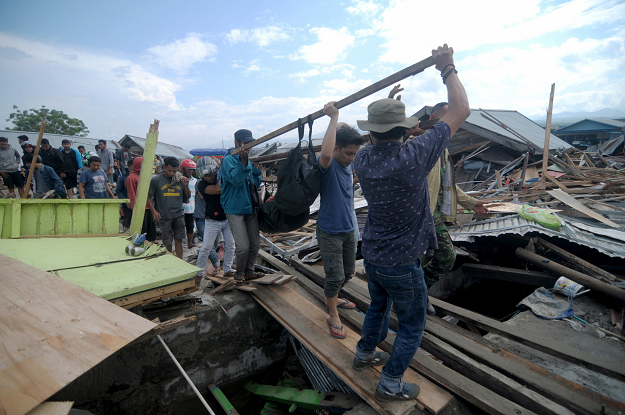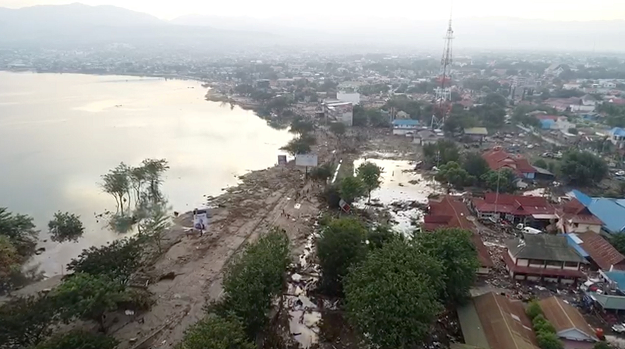
"It feels very tense," said 35-year-old mother Risa Kusuma, comforting her feverish baby boy at an evacuation centre in the gutted city of Palu. "Every minute an ambulance brings in bodies. Clean water is scarce. The minimarkets are looted everywhere."
Indonesian vice-president Jusuf Kalla said the toll could reach "a thousand, thousands" based on previous disasters.
At least 384 killed as quake, tsunami hit Indonesia
State media reported that the death toll had increased to 420 with a further 540 serious injured, but those figures were for Palu alone and relief agencies expressed fears that the number could spike once news started coming in from other affected areas.
"Worryingly, the National Disaster Management Agency has said they've received no information from the district of Donggala, which is closer to the epicentre of the earthquake," said Helen Szoke of Oxfam, referring to a region that is home to around 300,000 people.
In the coastal city of Palu on Sunday aid was trickling in, the Indonesian military had been deployed and search-and-rescue workers were doggedly combing the rubble for survivors -- looking for as many as 150 people at one upscale hotel alone.
When tsunamis strike: five deadliest disasters
"We managed to pull out a woman alive from the Hotel Roa-Roa last night," Muhammad Syaugi, head of the national search and rescue agency, told AFP. "We even heard people calling for help there yesterday."
"What we now desperately need is heavy machinery to clear the rubble. I have my staff on the ground, but it's impossible just to rely on their strength alone to clear this."
There were also concerns over the whereabouts of hundreds of people who had been preparing for a beach festival when the 7.5-magnitude quake struck Friday, sparking a tsunami that ripped apart the city's coastline.
 People walk through a residential area after an earthquake and tsunami in Palu.PHOTO: REUTERS
People walk through a residential area after an earthquake and tsunami in Palu.PHOTO: REUTERSAmid the levelled trees, overturned cars, concertinaed homes and flotsam tossed up to 50 metres inland, survivors and rescuers struggled to come to grips with the scale of the disaster.
Indonesian president Joko Widodo was expected to travel to the region to see the devastation for himself on Sunday.
On Saturday evening, residents fashioned makeshift bamboo shelters or slept out on dusty playing fields, fearing powerful aftershocks would topple damaged homes and bring yet more carnage.
Quake strikes off Indonesia, bringing down 'many buildings'
C-130 military transport aircraft with relief supplies managed to land at the main airport in Palu, which re-opened to humanitarian flights and limited commercial flights, but only to pilots able to land by sight alone.
Satellite imagery provided by regional relief teams showed the severe damage at some of the area's major sea ports, with large ships tossed on land, quays and bridges trashed and shipping containers thrown around.
Hospitals were overwhelmed by the influx of those injured, with many people being treated in the open air. There were widespread power blackouts.
 Residents helping remove a body after an earthquake and tsunami hit Palu. PHOTO: AFP
Residents helping remove a body after an earthquake and tsunami hit Palu. PHOTO: AFP"We all panicked and ran out of the house" when the quake hit, said Anser Bachmid, a 39-year-old Palu resident. "People here need aid -- food, drink, clean water."
Dramatic video footage captured from the top floor of a parking ramp as the tsunami rolled in showed waves bringing down several buildings and inundating a large mosque.
"I just ran when I saw the waves hitting homes on the coastline," said Palu resident Rusidanto, who like many Indonesians goes by one name.
About 17,000 people had been evacuated, the government disaster agency said and that number was expected to soar.
"This was a terrifying double disaster," said Jan Gelfand, a Jakarta-based official at the International Federation of Red Cross and Red Crescent Societies.
"The Indonesian Red Cross is racing to help survivors but we don't know what they'll find there."
Images showed a double-arched yellow bridge had collapsed with its two metal arches twisted as cars bobbed in the water below.
A key access road had been badly damaged and was partially blocked by landslides, the disaster agency said.
 PHOTO: REUTERS
PHOTO: REUTERSFriday's tremor was also felt in the far south of the island in its largest city Makassar and on neighbouring Kalimantan, Indonesia's portion of Borneo island.
The initial quake struck as evening prayers were about to begin in the world's biggest Muslim majority country on the holiest day of the week, when mosques are especially busy.
Indonesia is one of the most disaster-prone nations on earth.
It lies on the Pacific "Ring of Fire", where tectonic plates collide and many of the world's volcanic eruptions and earthquakes occur.
Earlier this year, a series of powerful quakes hit Lombok, killing more than 550 people on the holiday island and neighbouring Sumbawa.
Indonesia has been hit by a string of other deadly quakes including a devastating 9.1-magnitude earthquake that struck off the coast of Sumatra in December 2004.
That Boxing Day quake triggered a tsunami that killed 220,000 throughout the region, including 168,000 in Indonesia.

1731570137-0/BeFunky-collage-(56)1731570137-0-165x106.webp)
1731570357-0/elon-musk-(1)1731570357-0-165x106.webp)


1731569693-0/Copy-of-Untitled-(39)1731569693-0-270x192.webp)
1731563032-0/Copy-of-Untitled-(38)1731563032-0-270x192.webp)










COMMENTS
Comments are moderated and generally will be posted if they are on-topic and not abusive.
For more information, please see our Comments FAQ